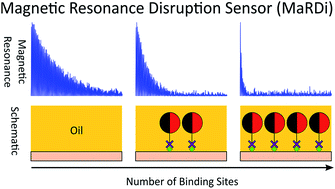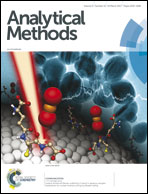A magnetic resonance disruption (MaRDi) technique for the detection of surface immobilised magnetic nanoparticles†
Abstract
There are numerous assays that result in a surface with bound magnetic nanoparticles (MNP) whose number is proportional to the concentration of the analyte of interest. The techniques used to explore such assays are typically complex and costly. Since the presence of such MNP disrupts the pulsed magnetic resonance signal that would normally be detected from a fluid covering the surface, we present a measurement technique to quantify such assays. In this work we identify and characterise a suitable fluid for such measurements, namely 10 cSt viscosity PDMS oil of thickness 250 μm. We demonstrate that the Teff2 relaxation time from the PDMS reduces as the proportion of the surface area covered with MNP increases. Most significant however, is a linear decrease in the signal amplitude from the PDMS as a function of MNP coverage. This is observed both for the integral over 4096 echoes and also in the first echo promising simplified console electronics for rapid measurements.



 Please wait while we load your content...
Please wait while we load your content...